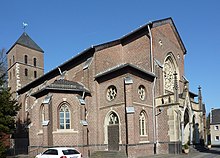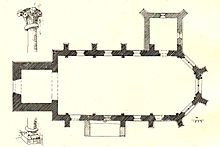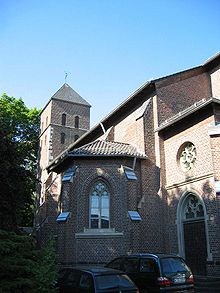St. Mary's Birth (Cologne)
St. Mary's Birth is a Roman Catholic parish and pilgrimage church in Cologne-Stammheim . The patron saint of the Archdiocese of Cologne, St. Mary, is venerated with the image of the Joyful Mother. The pilgrimage time is the feast of the Ascension of Christ and the octave around September 8th.
history
The Stammheim chapel was first mentioned in a document in 1075. At the beginning of the 14th century, today's Marienkapelle was built, which was expanded in 1905 with a neo-Gothic extension.
chapel
Stammheim belonged to the parish of Flittard , which had been in the possession of the Groß St. Martin monastery since 989 . Initiated by the Archbishop of Cologne Anno II (1056-1075), the little church in Stammheim, which Almericus, the ministral of the Archbishop of Cologne, and his wife Eilbusch built, was given to the St. Martin Monastery in Cologne. Remains of the Romanesque church may have been preserved in 1901 in the irregular masonry of the basement tower described by the art historian Paul Clemen . A new single-nave nave was added to the tower in the middle of the 13th century, the buttresses and window openings of which were changed around 1500. The upper parts of the Gothic tower masonry also came from the same time. The miraculous image of the joyful mother of Stammheim made in the 16th century made the church an important place of pilgrimage to Mary. Various processions to Stammheim have been documented since the 17th century.
extension
Due to the steadily growing population of Stammheim, the chapel had become too small for the large number of believers. Since an expansion of the church building had become necessary, the church building association was founded on March 6, 1898 under the protectorate of Count von Fürstenberg-Stammheim . After the building permit was granted by the Vicariate General on March 14, 1902 and by the royal government on June 7, 1902, the groundbreaking ceremony took place on June 19, 1902. The foundation stone was finally laid on September 14, 1902. After a good 13 months of construction, the new church building was consecrated on August 2, 1903 by Dechant Caumanns. According to the head of the renovation, Prof. Kleesattel, the total cost of the extension was 101,463.01 marks.
The extension was made in the form of a neo-Gothic hall church with a main and two side aisles . Both the tower and the choir of the old church building were preserved in the new church and formed the transept of the new building. Since the original chapel was built in a west-east orientation and the old choir, as is customary with sacred buildings, faced east, the new apse faced north. At the southern end of the nave, the new main portal was built, over which the organ gallery rose. The side walls, pierced by large pointed arched windows, were supported from the outside with stepped buttresses, and the facade was bricked with fired ring oven bricks, used for cornices and filigree stone carvings, the so-called tracery , white tuff . The pillars inside the church were made with Kyllburg sandstone . Like the old chapel, the extension was given a pitched roof .
destruction
The Second World War did not leave St. Mary's Birth without a trace. While only the roof was damaged by its own anti-aircraft defense until 1941 , considerable damage was caused by air raids in the following years. At the beginning of 1944, the first church windows were broken by bombs and air mines exploding nearby. On October 10, 1944, during the second attack of the day, several stick bombs fell on the nave , causing the roof of the church to catch fire. The wind drove the fire north, so that the tower roof also went up in flames. The extinguishing work was initially delayed by further air raids with high explosive bombs . After the all-clear, the fire had advanced so far that the fire could no longer be contained with the available water. The order from the Security Assistance Service (SHD) to extinguish only residential buildings even resulted in a fire engine from the SHD standing by the church and watching the fire. Only the courageous intervention of parishioners was able to prevent the flames from spreading to the sacristy , the Marienchor and the organ gallery. The inventory of the church was saved by a quick evacuation operation by women, children and some old men. In the following months the church was hit by artillery shells several times . a. a large shell crater was built in front of the Marien Altar.
Nevertheless, the damage balance after the war looked quite bleak. In addition to the roof, which was completely burned down except for the roof of the sacristy and the Marian choir, all club and church flags, the processional canopy and the 600 kg Christ-King bell from 1454 were destroyed. The artillery fire also destroyed the warrior memorial altar and the Marien altar was damaged by shrapnel.
reconstruction
Since it seemed impossible immediately after the end of the war to get building material for the repair of the church building, the citizens of Stammheim kept their eyes open to find any usable material that had been left behind. A bridge yoke of a makeshift bridge with a stack of around 170 large wooden planks was quickly found at the Stammheim water tower, which lay on the bottom of the Rhine and protruded from the water. Without further ado, volunteers carried the planks the one kilometer way to the church. Almost four months after the end of the war in Cologne, work began on August 24, 1945 to rebuild the roof structure of the nave and the choir. Due to a shortage of skilled workers and materials, however, the roof could not be completed until 1947 and not completely sealed until 1948. Contrary to the historical shape of the roof, a pitched roof was not built for cost and material reasons and only a sloping roof was installed.
At the same time, the tracery, cornice stones and windows were restored, some of which were only made with raw glazing. However, the repair of the war damage proceeded only slowly, as the expenditure clearly exceeded the financial framework. August 17, 1947 brought the parish an unexpected financial blessing, as many Stammheim residents insisted on donating on the occasion of Pastor Peter Zappey's 25th anniversary as a priest. On July 24, 1950, according to plans by the architect Bongartz, heightening the tower was started and completed in August of the same year with the installation of the tent roof . On August 11th of the same year, the first of five new bells, the St. Anne's bell, was cast and hung in the bell tower on August 28, 1950, one day after the dedication.
renovation
The building has been renovated twice since it was rebuilt after World War II. While the first renovation took place in the 1970s, the entire church building was renovated again at the end of the 1990s and the technical systems were renewed. The renovation was carried out in several construction phases so that the regular trade fairs could continue to take place. In the first section, the building was covered with a scaffolding structure and a temporary scaffolding roof was put on so that the entire roof could be covered and re-covered. Subsequently, parts of the church interior were closed to visitors and extensively renovated. The completion of the work was the installation of a new window in 2000, which was donated by the Montagsbastelkreis, and the installation of the new organ.
literature
- Paul Clemen (arrangement) in connection with Edmund Renard : The art monuments of the Mülheim am Rhein district (= The art monuments of the Rhine province. Fifth volume. II.). Schwann, Düsseldorf 1901, p. 85.
- Manfred Becker-Huberti, Günther A. Menne (ed.): Cologne churches. The churches of the Catholic and Protestant communities in Cologne. Bachem, Cologne 2004.
Web links
Coordinates: 50 ° 59 ′ 12 " N , 6 ° 59 ′ 7.2" E





